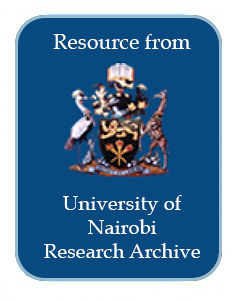Location
Our Vision is to be a world-class university committed to scholarly excellence.
Our Mission is to provide quality university education and training and to embody the aspirations of the Kenyan people and the global community through creation, preservation, integration, transmission and utilization of knowledge.
Core Values
In order to realize the above vision and mission, certain shared values shall be nurtured. There is great need for the University to be guided by the right values derived from the virtues and moral standards of the Kenyan and wider society.
Core Functions
Teaching and Learning: The university offers innovative , relevant and market driven academic programmes , both at undergraduate and postgraduate levels with inbuilt quality control systems the university also provides an environment and policy framework for undertaking high quality and relevant research
Members:
Resources
Displaying 141 - 145 of 298Macrofauna diversity and abundance across different land use systems in Embu, Kenya
This paper presents data on diversity and abundance of soil macrofauna of various land use systems in Embu, Kenya (natural forest, plantation forest, fallow, coffee, tea, napier, and maize). Each was sampled for macrofauna using three sampling methods (monolith,
transect and pitfall traps). Thirty four (34) genera/species of soil macrofauna were recorded, the highest number (27) being observed in napier. Majority of these genera/species being Coleoptera. Rényi diversity profile indicated that in terms of
Influence of land use and soil management practices on the occurence of nematode destroying fungi in Taita Taveta,Kenya
Due to the increased concerns about the effect of agrochemicals
on soil health and soil biodiversity, use of
biological methods has become most acceptable
alternative methods for farmers to control soil
pathogens during crop production. A study was
therefore undertaken to determine the occurrence of
nematode destroying fungi in Taita Taveta with the
aim of isolating and characterizing them for biological
control of plant parasitic nematodes. Twenty eight
fungal isolates, distributed in three genera, were
Soil Use and Management Effects on Aggregate Stability, Organic Matter and Hydraulic Conductivity Within River Njoro Watershed in Kenya.
There has been tremendous changes in soil use and management in the River Njoro Watershed during the last three decades. Formerly large-scale farms converted into smallholder farms and plantation forests have gradually been lost. These changes in soil use have brought in different soil use and management approaches that have triggered soil erosion and other forms of land degradation. Up to 8.6 Kg of soil, loss per hectare from the cultivated soils has reportedly been lost in one storm. This massive soil loss was probably due to reduced aggregate stability and hydraulic conductivity.
Effect of land use and soil fertility management practices on nematode destroying fungi in Taita, Kenya
The study was undertaken to investigate how land use and soil fertility management practices affect the occurrence of nematode destroying fungi. The aim of the study was to harness the potential of these fungi to control the plant parasitic nematodes in the study area which is a very important vegetable catchment in the Coast Province of Kenya
Land-Use Change and Livestock Production Challenges in an Integrated System: The Masai-Mara Ecosystem, Kenya
Participatory rural appraisal techniques and a survey of 100 households were used to evaluate livestock production, and pastoral development of the Maasai in Mara. It was observed that patterns of land-use have principally changed from nomadic pastoralism to sedentary pastoralism, agropastoralism, and, in some cases, pure cultivation. These trends have adversely affected livestock production and the productive capacity of the Mara ecosystem.






